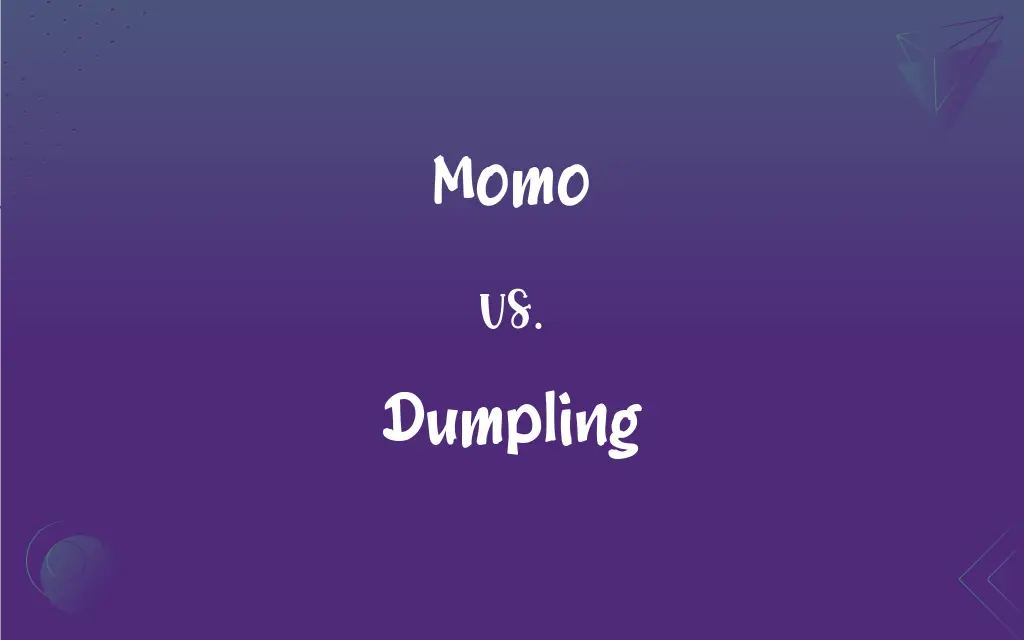Momo vs. Dumpling: What's the Difference?
Edited by Harlon Moss || By Janet White || Updated on October 6, 2023
Momo is a type of dumpling originating from Tibet, typically filled with meat or vegetables; dumpling is a broad term for a dish consisting of pieces of dough, often wrapped around a filling, found in various cuisines.

Key Differences
Momo and dumpling are terms often used interchangeably as momo is a subtype of dumpling. Momo originates from Tibet and is traditionally filled with meat, like pork, chicken, or buffalo, or various vegetables, enclosed in a dough, and then steamed or fried. It is a significant dish in Nepalese, Tibetan, and Indian cuisines and usually served with a dipping sauce, like chutney or a sesame-based sauce, making it a flavorful and wholesome meal.
Dumpling, on the other hand, is a universal term used to describe a broad category of dishes that are made by enclosing a filling in dough or batter. Dumplings are prevalent in many world cuisines, with each having its unique preparation methods, ingredients, and cooking techniques. They can be sweet or savory, steamed, boiled, fried, or baked, showcasing the diversity in dumpling preparations across different culinary traditions.
While momo is specific in its origin and traditional preparation methods, the term dumpling encompasses a myriad of variations, each ingrained in its cultural context. Dumplings can have various fillings, from meat and vegetables to fruits and sweets, and can be made with different types of dough, reflecting the culinary diversity of this dish. They can be found in Chinese, Japanese, Korean, Polish, Italian, and many other cuisines, each offering its unique twist to this versatile dish.
The specificity of momo distinguishes it from the general classification of dumplings. Momo has a defined set of preparation methods and traditional ingredients, reflecting its cultural roots in Tibetan cuisine. It is a dish that carries its heritage and is revered in the regions where it is a staple, contributing to the rich tapestry of global culinary arts.
In conclusion, while momo is a specific type of dumpling with its origin, preparation method, and traditional fillings, dumpling is a more inclusive term that refers to a variety of dishes across different cuisines, each having its unique identity, preparation, and flavor profile.
ADVERTISEMENT
Comparison Chart
Origin
Tibet
Various cultures globally
Type
A specific type of dumpling
A broad category including various types of dishes
Preparation
Typically steamed or fried
Can be steamed, boiled, fried, or baked
Filling
Traditionally meat or vegetables
Can be filled with meat, vegetables, sweets, etc.
Cuisine
Primarily found in Nepalese, Tibetan, and Indian cuisines
Found in numerous world cuisines
ADVERTISEMENT
Momo and Dumpling Definitions
Momo
A dumpling usually filled with meat or vegetables.
The vegetarian momo were filled with a flavorful mix of vegetables.
Dumpling
A dish made of dough, often filled, found in many cuisines.
The soup contained several delicious dumplings.
Momo
A type of steamed dumpling originating from Tibet.
The spicy sauce complemented the savory flavor of the momo perfectly.
Dumpling
Typically cooked by boiling, steaming, frying, or baking.
We enjoyed some steamed dumplings at the Chinese restaurant.
Momo
A traditional dish in Nepalese, Tibetan, and Indian cuisines.
When visiting Nepal, trying the local momo is a must.
Dumpling
Can be sweet or savory and have various fillings.
The sweet dumpling was filled with red bean paste.
Momo
Can be steamed or fried, depending on preference.
I prefer fried momo for their crispy texture.
Dumpling
A versatile dish with different preparations worldwide.
Each country has its unique take on the traditional dumpling.
Momo
Typically served with a variety of dipping sauces.
The momo tasted excellent with the tangy sesame sauce.
Dumpling
A piece of dough, sometimes filled, that is cooked in liquid such as water or soup.
Momo
A type of dumpling from Nepal, Ladakh or Tibet made with a simple flour and water dough and filled with meat, vegetables or cheese.
Dumpling
Sweetened dough wrapped around fruit, such as an apple, baked and served as a dessert.
Momo
A moron.
Dumpling
(Informal) A short, chubby creature.
Dumpling
(culinary) A ball of dough that is cooked and may have a filling and/or additional ingredients in the dough.
Dumpling
By restriction, a food composed of a dough wrapper around a filling.
Dumpling
(endearing) A term of endearment.
My little dumpling.
Dumpling
A piece of excrement.
Dumpling
A roundish mass of dough boiled in soup, or as a sort of pudding; often, a cover of paste inclosing an apple or other fruit, and boiled or baked; as, an apple dumpling.
Dumpling
Small balls or strips of boiled or steamed dough
Dumpling
Dessert made by baking fruit wrapped in pastry
Dumpling
Encloses a filling in a piece of dough or batter.
The dumpling had a rich, meaty filling encased in soft dough.
FAQs
Is momo only found in Tibetan cuisine?
While originating from Tibet, momo is also a significant dish in Nepalese and Indian cuisines.
Can dumplings be sweet?
Yes, dumplings can be sweet or savory, depending on the cuisine and recipe.
Are all dumplings made with the same dough?
No, the dough for dumplings can vary widely depending on the recipe and cuisine.
Is the filling in momo always meat?
No, momo can be filled with meat, vegetables, or a combination of both.
Can momo be fried?
Yes, momo can be either steamed or fried based on preference.
Is dumpling a universal term in culinary arts?
Yes, dumpling is a broad and universally recognized term for a variety of similar dishes in different cuisines.
Are momo and dumplings the same in flavor profile?
No, the flavor profile of momo and other dumplings can vary significantly based on ingredients and cuisine.
Can dumplings be a standalone dish?
Yes, dumplings can be served as a standalone dish or as part of a dish like soup.
Is momo a type of dumpling?
Yes, momo is a specific type of dumpling originating from Tibet.
Can dumplings be baked?
Yes, dumplings can be boiled, steamed, fried, or baked.
Are dumplings always served as part of a meal?
Dumplings can be a meal, part of a meal, or served as appetizers or desserts, depending on the type.
How diverse are dumpling preparations?
Dumpling preparations are highly diverse, with different cooking methods and fillings found worldwide.
Can momo be served without sauce?
While typically served with sauce, momo can be eaten without it based on personal preference.
Do momo and dumplings have a fixed shape?
No, momo and dumplings can be crafted into various shapes depending on the tradition and preference.
Is momo preparation method fixed?
While traditionally steamed or fried, the preparation of momo may have variations.
About Author
Written by
Janet WhiteJanet White has been an esteemed writer and blogger for Difference Wiki. Holding a Master's degree in Science and Medical Journalism from the prestigious Boston University, she has consistently demonstrated her expertise and passion for her field. When she's not immersed in her work, Janet relishes her time exercising, delving into a good book, and cherishing moments with friends and family.
Edited by
Harlon MossHarlon is a seasoned quality moderator and accomplished content writer for Difference Wiki. An alumnus of the prestigious University of California, he earned his degree in Computer Science. Leveraging his academic background, Harlon brings a meticulous and informed perspective to his work, ensuring content accuracy and excellence.
































































